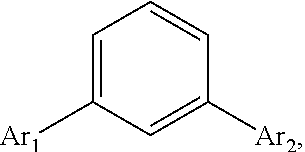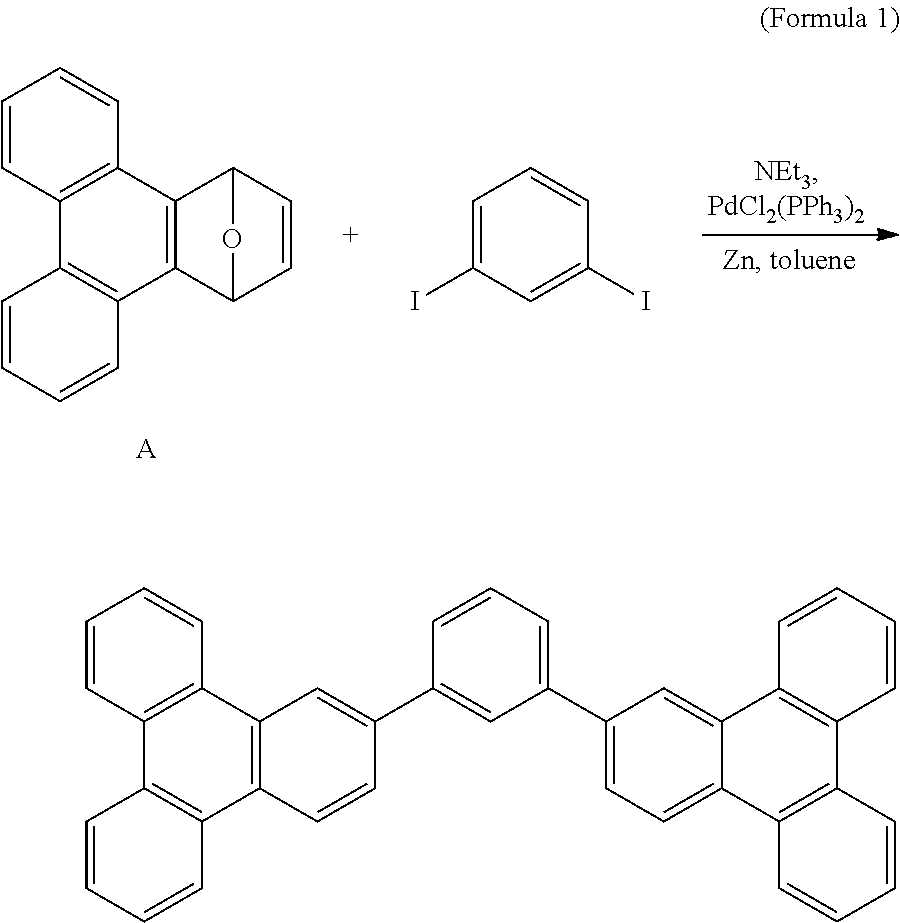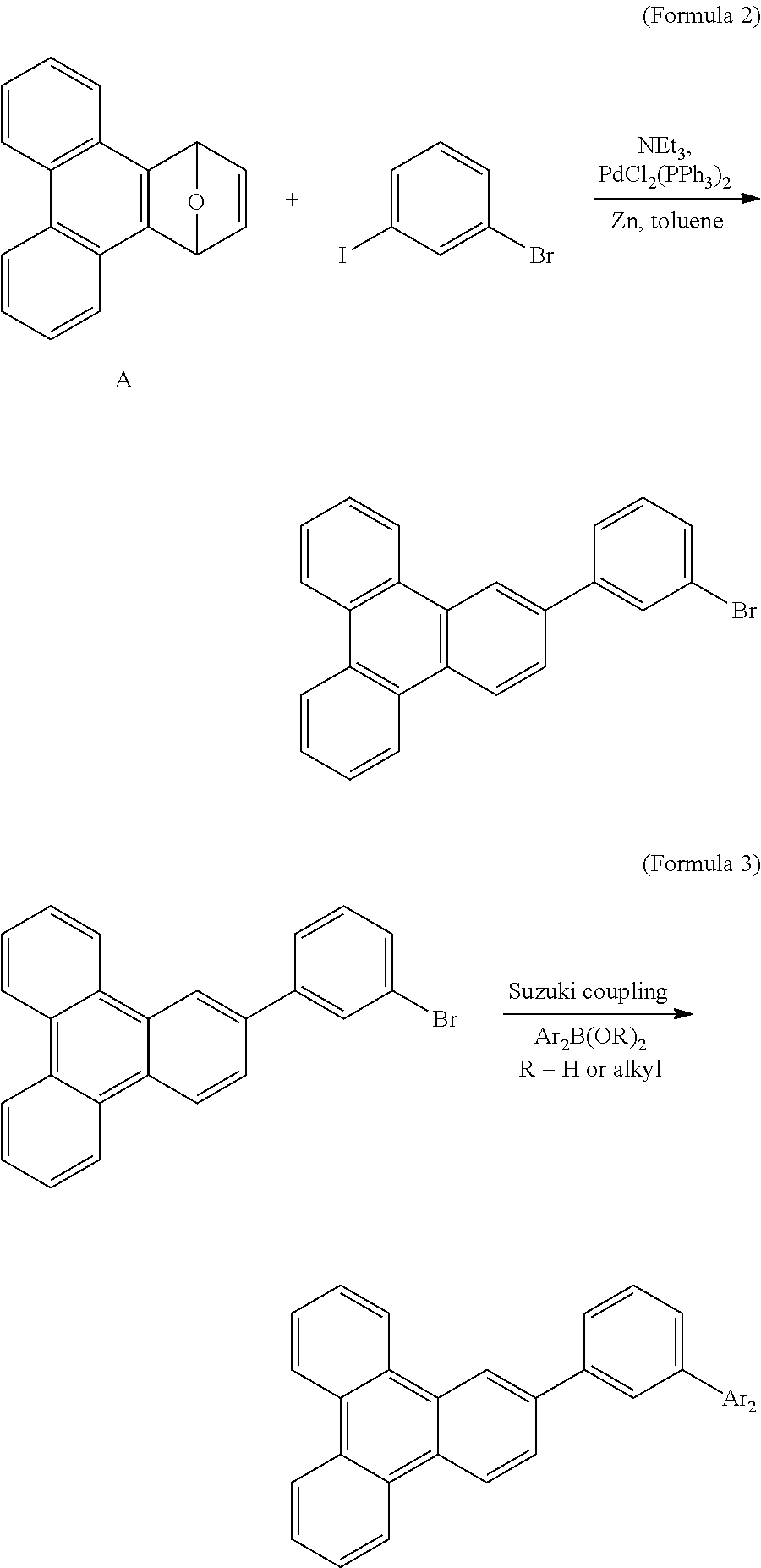Triphenylene based aromatic compounds and oleds utilizing the same
a technology of aromatic compounds and triphenylene, which is applied in the direction of discharge tube luminescnet screens, organic chemistry, natural mineral layered products, etc., can solve the problems of difficult growth of large crystallization areas, low organic material efficiency, and high driving voltage of devices
- Summary
- Abstract
- Description
- Claims
- Application Information
AI Technical Summary
Problems solved by technology
Method used
Image
Examples
example 1
[0023]As shown in Formula 1, the compound A (1.00 g, 4.1 mmol), 1.3-diiodobenzene (0.63 g, 1.9 mmol), zinc (2.69 g, 41.4 mmol), and PdCl2(PPh3)2 (0.44 g, 0.6 mmol) were charged in a two-necked bottle. The bottle was then vacuumed and purged with nitrogen, and dried toluene (88 mL) and triethyl amine (5.75 mL, 41.5 mmol) were added to the bottle. The mixture in the bottle was heated to 100° C. for reaction for 24 hours, and the resulting was filtered to remove metal. The filtrate was condensed to remove the solvent, and then purified by chromatography with an eluent of dichloromethane / n-hexane (1:6) to obtain a product. The product was sublimated at a temperature of 305° C. to obtain a white solid of 0.57 g (yield=56%).
[0024]The white solid product in Formula 1 was dissolved in dichloromethane to form a solution having a concentration of 10−5M, or evaporated to form a film having a thickness of 30 nm. The absorption-emission peaks of the film and the solution are tabulated in Table 1...
example 2
[0026]As shown in Formula 2, compound A (4.00 g, 16.4 mmol), zinc (10.72 g, 163.9 mmol), and PdCl2(PPh3)2 (1.16 g, 1.7 mmol) were charged in a two-necked bottle. The bottle was then vacuumed and purged with nitrogen, and dried toluene (350 mL), 1-bromo-3-iodobenzene (2.08 mL, 16.4 mmol), and triethyl amine (5.75 mL, 41.5 mmol) were added to the bottle. The mixture in the bottle was heated to 100° C. for reaction for 24 hours, and the resulting was filtered to remove metal. The filtrate was condensed to remove the solvent, and then purified by chromatography with an eluent of n-hexane to obtain a white solid of 3.42 g (yield=54%). The white solid product in Formula 2 was dissolved in dichloromethane to form a solution having a concentration of 10−5M, or evaporated to form a film having a thickness of 50 nm. The absorption-emission peaks of the film and the solution are tabulated in Table 1.
[0027]The spectra data of the product in Formula 2 is shown as follows. 1H NMR (400 MHz, CDCl3)...
example 3
[0031](2-bromoethene-1,1,2-triyl)tribenzene (5.00 g, 14.9 mmol) was charged in a reaction bottle. The reaction bottle was then heated, vacuumed, and purged with nitrogen. Dried tetrahydrofuran (50 mL) was added to the reaction bottle and stirred until (2-bromoethene-1,1,2-triyl)tribenzene was dissolved, and the solution was cooled to −78° C. n-BuLi (15.00 mL, 30.00 mmol, 2.0 M n-hexane solution) was dropwise added to the cooled solution, and the reaction was stirred at −78° C. for 1 hour. Subsequently, B(OBu)3 (11.00 mL, 40.8 mmol) was added to the reaction for reaction for another 8 hours. The resulting mixture was acidified by HCl (2.0 M, 300 mL) for 3 hours. The acidified mixture was extracted by ethyl acetate to collect the organic layer thereof. The organic layer was dried by MgSO4 and then condensed to precipitate a solid. The solid was washed by n-hexane and filtered to obtain a white solid of 2.91 g (yield=65%) as shown in Formula 6.
[0032]The spectra data of the compound in ...
PUM
| Property | Measurement | Unit |
|---|---|---|
| Temperature | aaaaa | aaaaa |
| Temperature | aaaaa | aaaaa |
| Temperature | aaaaa | aaaaa |
Abstract
Description
Claims
Application Information
 Login to View More
Login to View More - R&D
- Intellectual Property
- Life Sciences
- Materials
- Tech Scout
- Unparalleled Data Quality
- Higher Quality Content
- 60% Fewer Hallucinations
Browse by: Latest US Patents, China's latest patents, Technical Efficacy Thesaurus, Application Domain, Technology Topic, Popular Technical Reports.
© 2025 PatSnap. All rights reserved.Legal|Privacy policy|Modern Slavery Act Transparency Statement|Sitemap|About US| Contact US: help@patsnap.com



